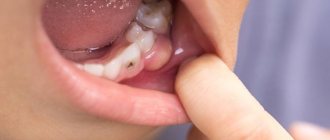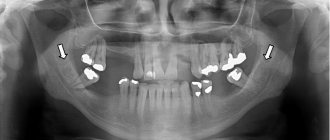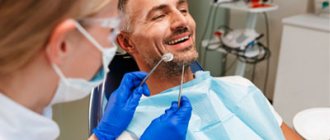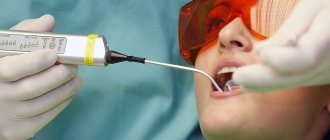- Questions and answers
- Stock
- Reviews
- Causes
- Types of cysts
- Symptoms
- Treatment
| Prices | Causes | Types of cysts | Symptoms | Treatment |
A dental cyst is a pathological neoplasm that occurs as a result of the body’s defensive reaction to infection or injury. A cyst occurs when pathogenic microorganisms that cause inflammation enter the jaw bone tissue through the root canal. Gradually, the cells involved in the disease process die, forming a cavity in the bone tissue. To prevent the spread of the process, our body forms a capsule with dense walls around the necrosis zone.
The resulting neoplasm contains inflammatory fluid, dead cells, decay products and bacteria. Sizes range from a few millimeters to several centimeters. Small ones (less than 5 mm in diameter) are called granulomas. Granuloma, cystogranuloma and cyst are stages of the inflammatory process in the bone tissue of the jaw. As long as it is small, there will be no manifestations. The number of microbes in it continues to grow, but since this happens under the control of the immune system, the process develops unnoticed. Immune cells are sent to the cyst through the blood vessels that feed the bone tissue. This is how the body tries to cope with the problem. But, if the immune system weakens, the disease enters the acute phase.
The development of the disease can lead to serious consequences. An increase in size threatens a fracture (especially of the lower) jaw, loss of teeth involved in the inflammatory process, and degeneration into a malignant tumor. Exacerbation of the disease leads to the development of periostitis, purulent abscess or even osteomyelitis. If at this stage the patient does not receive qualified medical care, sepsis may begin. This is an extremely serious condition, characterized by infection entering the blood and subsequently spreading throughout the body.
Types of cysts
Root cyst
Develops from granuloma as a continuation of pulpal necrosis (death of pulp tissue) and as a result of periapical inflammation. It is located in the apical (apical) third of the tooth root and sometimes has a transverse orientation due to additional canals, the initial paths for the spread of pulpous necrosis.
Root cysts are radiolucent capsules with well-defined boundaries. They can vary greatly in size from 2-3 mm to 2-3 cm. In the absence of secondary inflammation, the roots develop asymptomatically. Even the largest neoplasms do not displace teeth or expand bone tissue.
Once diagnosed, treatment requires eliminating the underlying cause. The most common treatment for pulp necrosis is endodontic treatment. If it is unsuccessful, a decision is made on surgical curettage or enucleation.
Residual
Remains after removal of the pathology. It can form in the granuloma left after tooth extraction or around the left apex of the root.
The residual cyst is clearly visible on x-ray. Its dimensions range from a few millimeters to several centimeters.
Follicular cyst on the gum
A cyst in the gum develops from a follicular sac that encloses each unerupted tooth. This is a capsule clearly visible on an x-ray, most often surrounding the crown of an unerupted tooth. May cause extensive tooth damage. It has a rapid growth rate, can move to adjacent teeth and lead to expansion of the cortical plate.
Clinically, a follicular cyst always occurs in the area where the enamel meets the cementum of the tooth (the place of attachment of the follicle). Due to its growth, adjacent teeth may tilt, and in rare cases, resorption (destruction) of tooth roots occurs. Unerupted teeth can also become displaced due to aggressive growth. If a follicular neoplasm has been identified, its treatment may include surgical curettage (curettage).
Eruption cyst
This is a fluid-filled follicular sac that usually occurs during teething. It covers the erupting tooth and often contains blood. Outwardly it looks like pronounced swelling of soft tissues of a bluish color (due to the presence of blood). Most often it occurs due to slow tooth eruption and can rupture spontaneously. However, in some cases where it is found, treatment may include surgical resection to help the tooth erupt faster.
Primordial (keratocyst)
Develops from the tooth germ as a result of degeneration of the stellate reticulum during tooth development before the onset of calcification of its tissues. Keratocysts can arise from any developing tooth germ, but most often they are localized in the area of premolars and the third molar of the mandible.
Clinically very prone to relapse. If the patient is diagnosed, treatment consists of careful curettage and close follow-up to ensure early detection of recurrence of pathology.
Lateral periodontal
The exact reasons for their occurrence are not fully known. They are rarely large. They are clearly visible on an x-ray and are most often closely associated with the lateral surface of the tooth root. Typically, teeth associated with these cysts have normal pulp. When a lateral periodontal neoplasm (cyst) is detected on the root of a tooth, treatment consists of surgical curettage without compromising the integrity of the tooth. It is important that the removed tissue is sent for histological analysis to rule out more serious pathologies such as early adamantinoma.
Calcifying odontogenic
Their etiology is also completely unknown. They can be found in any area of the supporting surface of the jaws, most often in the lower part. Morphologically they are quite diverse. Clearly visible on x-ray and may contain various opacities depending on the degree of calcification of the tumor. Once diagnosed, treatment consists of surgical curettage or resection.
Etiology and provoking factors
The appearance of a cystic component is the body’s response to the inflammatory process in the tooth. Cysts form in patients with a long course of carious destruction, when the lesion reaches the root part of the tooth. But there are other diseases or conditions that can serve as a trigger for the formation of cavity formations:
chronic periodontitis; severe pulpitis; trauma to the tooth and gums: previous illness of an infectious nature; chronic stomatitis; inflammation of the maxillary sinuses; abnormal bite; catarrhal otitis; diseases with a pronounced decrease in immunity; complication during the eruption of wisdom teeth.
A radicular cyst of the maxillary bone is most often formed under the influence of a long-term untreated carious tooth. Sometimes the cause of the appearance of a radicular cyst in the upper jaw is unprofessional treatment of caries, violation of canal filling technology, or lack of competence of a specialist in the treatment of chronic forms of periodontitis. Lack of treatment for a radicular cyst can lead to serious complications not only from the maxillofacial anatomical zone, but also from all organs and systems of the body as a whole.
Symptoms of a dental cyst
Most often it is formed as a result of traumatic injury or infection, for example, due to poor-quality root canal filling in the sinus of the tooth. Often this pathology occurs against the background of frequent sinusitis. Treatment should begin with a visit to the dentist and an x-ray. At an early stage it does not manifest itself in any way. The primary symptom is discomfort when chewing solid food.
As it develops, a protrusion of bone tissue or a fistula on the gum in the area of the apex of the damaged tooth may be observed.
When the disease worsens, patients complain of acute pain. The reason for the transition of the disease to the acute phase may be a weakened immune system, relapses of chronic diseases, hypothermia, infectious diseases, or the use of certain medications, such as immunosuppressants (drugs that artificially suppress the immune system). An exacerbation may be accompanied by the following symptoms:
- swelling of the face in the area of the damaged area;
- increased body temperature;
- general malaise;
- enlargement and tenderness of the submandibular cervical lymph nodes;
- pain in the area of the damaged tooth, intensifying when chewing.
You should not ignore these symptoms if you want to undergo treatment without tooth extraction. When the first signs of illness appear, you should immediately seek help from a dentist.
Causes of the disease
Already based on the classification, it becomes clear that tumors appear in the tissues of the oral cavity for a variety of reasons. Among the main provoking factors:
- Damage to hard dental tissues. Untreated caries, periodontitis, pulpitis are all diseases in which pathogenic agents penetrate the periodontium through unsealed root canals.
- Inflammation of the area adjacent to the area where the cyst is located. Quite often it turns out that a benign tumor formed after sinusitis or inflammation of the gums. This happens because the infection penetrates through the bloodstream into the bone tissue from the maxillary and nasal sinuses.
- Injuries, bruises, blows. The first time after them, a person may not notice anything. But later a nagging pain appears, indicating a problem.
Very rarely do doctors have to treat congenital cysts. It has not been established why they occur.
Treatment of a cyst without tooth extraction
The success of treatment directly depends on how early it was detected. Therefore, dentists recommend that patients undergo regular preventive examinations and seek help at the first signs of illness. More recently, therapy necessarily involved tooth extraction. Of course, this approach did not suit either the doctors or especially their patients. Today, dentists' methods have changed significantly, and it is possible to get rid of a cyst without losing the beauty of your smile.
Treatment of the cyst can be surgical or conservative. The choice of therapy method depends on: the type, age of the patient, personal wishes and is determined for each patient.
Clinical picture
The development of the cystic component can develop for about several years and does not manifest itself symptomatically. If unexpressed but unpleasant signs of a cyst appear, treatment should be carried out immediately, since treatment of the tumor after its significant growth will be quite difficult. As the cyst grows, it puts strong pressure on the surrounding connective tissue, so its growth is rapid. In the photographs, the cyst looks like a small spherical formation. The main manifestations are:
the appearance of severe throbbing pain; swelling and redness of the gums in the affected area; feeling of tooth mobility; feeling of fullness in the apical space; bad breath: prolonged persistence of low-grade body temperature.
An early cyst can be diagnosed by X-ray examination, and later stages of development are detected by visual examination of the patient’s oral cavity. Usually the suspicion of the presence of a cystic cavity is justified.
Surgery
Most often, a cystectomy procedure is performed to surgically remove a tumor. It involves removing the cyst and damaged root tip. The advantage of this method is its high efficiency. Its disadvantages include the fact that cystectomy is a rather complex operation, and not every surgeon decides to perform it.
A more complex method is hemisection. This operation is performed when one of the roots is completely destroyed. During surgery, the doctor removes the disease-causing capsule, damaged root and part of the tooth crown. The defect resulting from surgical resection is eliminated using composite materials or a crown.
Much depends on at what stage the capsule was discovered. Treatment can be accompanied by tooth extraction only if it is entirely located in the capsule of the cyst or its tissues are almost completely destroyed.
Content:
- Classification of pathology
- Causes of the disease
- Symptoms of the disease
- Diagnostic measures
- How to treat
- What will happen if left untreated?
- What can you do to avoid getting sick?
A jaw cyst is a hollow benign formation localized in the jaw bone.
There is liquid content inside it. Very often, the structure develops unnoticed by a person for a long time and is accidentally discovered during an X-ray diagnosis for another reason. If a cyst in the jaw becomes inflamed, the patient immediately feels it. Suppuration can provoke the occurrence of periostitis, sinusitis, osteomyelitis, and fistula.
Unfortunately, most often the formation has to be removed surgically. The doctor performs a resection of the apex of the tooth root and at the same time fills the cavity cleared of exudate with a special biological composite composition.
Conservative treatment
This type of therapy allows you to be cured without surgery. In this case, an incision is not required to gain access to the tumor. At the initial stage of treatment, the dentist drills out and cleans out the affected root canal. The apex of the tooth root connects to the cyst, so once the root canal is opened, the contents flow out. After cleaning and disinfecting the root canal, the doctor introduces antibiotics and substances into the cavity that destroy its capsule.
After this, the doctor fills the resulting cavity with a special paste that will help restore bone tissue. The hole is then filled. If after 6 months the cyst is not detected on an x-ray, the treatment can be considered successful. This method helps in about 75% of cases.
An innovative treatment method without surgery
is depophoresis. It helps eliminate infection in all root canals without drilling them. The dentist exposes the mouth of the canal and inserts an electrode into it. Another electrode is pressed against the surface of the cheek, which produces a weak current discharge. Together with the discharge, copper-calcium hydroxide is passed through the root canal, which penetrates into all hard-to-reach areas, destroying all bacteria, microorganisms and dead cells.
After three sessions of depophoresis, the damaged tooth is filled and its crown is restored. Regardless of what type of tumor was detected, treatment with depophoresis allows you to get rid of it in almost 100% of cases.
What can you do to avoid getting sick?
You can reduce the likelihood of developing the disease by following simple rules:
- Brush your teeth twice a day. Use a high-quality brush and paste during hygiene procedures. Don't forget about the role of dental rinses and dental floss.
- Once a year, remove tartar in the dental office using an ultrasonic scaler. Professional hygiene is the best prevention of most dental ailments.
- Eat a balanced and healthy diet. Eat less sweets. Eat plenty of fresh fruits and vegetables.
- Check your dental health once a year. You need to visit a doctor, even if nothing bothers you.
- Always follow your dentist's instructions.
- Avoid traumatic injuries to the face. When engaging in potentially dangerous sports, always wear special protective equipment.
A jaw cyst is a dangerous tumor. Initially it is benign, but under certain conditions it can become malignant. Fortunately, this happens extremely rarely.
If the tumor grows very quickly, even a jaw fracture is possible. It shouldn't come to this. Treatment must be timely and competent.
Cost of treating a cyst under a tooth
The price of dental services for the treatment of cysts in our clinic is about 8,500 rubles. and depends on the following factors:
- type;
- complexity of the disease;
- method of treatment (surgical or therapeutic);
- use of complex equipment;
- expenses for surgical or dental supplies;
| Service | Price |
| Consultation | |
| Orthopantomogram OPTG of the jaw | from 1,100 ₽ |
| Cystectomy | 5 300 ₽ |
| Hemisection | 3 300 ₽ |
Look at the detailed price list for dental treatment at NovaDent dentistry in Moscow and the pain-free region.
If you have been diagnosed with a dental cyst, it should be treated by a qualified dentist. Many patients do not fully understand the danger of this disease. Photos of the cyst can be found on the Internet. From them it can be understood that this can cause the destruction of large areas of bone tissue. And this, in turn, poses a risk of jaw fracture and tooth loss.
Expert of the article you are reading: Svetlana Viktorovna Derevyakina Chief physician, doctor of the highest qualification category, therapist, periodontist, leading specialist of the NovaDent network
28 years
Clinical experience
Petrovsko-Razumovskaya
Verkhniye Likhobory
st. Dubninskaya, 27, building 1
+7
Free consultation with this specialist
What will happen if left untreated?
Despite the fact that most patients do not have acute symptoms with the diagnosis described, the growth of the cavity can lead to very unpleasant and even dangerous consequences for health. This means:
- sepsis;
- phlegmon;
- premature loosening and loss of one or more teeth;
- inflammatory damage to the tissues of the periosteum;
- the formation of a malignant tumor due to cell degeneration;
- osteomyelitis;
- frequent occurrence of fistulas;
- high risk of fracture.
All these consequences are not harmless, which is why it is so important to detect pathology at the very beginning of its development.
Treatment process
Treatment of cysts can be therapeutic (conservative) or surgical. The treatment method is determined by the doctor after a visual examination of the oral cavity and the results of diagnostic studies.
Laser treatment
Laser beam treatment is gaining increasing popularity in dentistry. Under the influence of a laser, a tumor can be removed completely painlessly, without the risk of infection. In addition, the laser completely disinfects the affected channels and ensures rapid recovery. The laser treatment algorithm looks like this:
opening and expansion of dental canals; introduction of a laser beam into the canals: disinfection and removal of the cystic component.
The only disadvantages of the method are the relative high cost and the need for special high-precision equipment. Laser treatment also involves following the doctor’s recommendations immediately after the procedure (rinsing with an antiseptic and abstaining from food for up to 5 hours).
Conservative treatment
Therapy for a cystically altered tooth root requires disinfection, tooth cleaning and filling. An alternative treatment method is the introduction of a therapeutic suspension containing copper and calcium, followed by exposure of the tooth to low-power electrical discharges. The main indications for drug therapy are:
absence of fillings on root canals; poor filling in the root canals (not along the entire length); The size of the cyst barely reaches 8 mm.
In treatment, special drugs are used that negatively affect the cyst capsule and its contents. After which, the purulent exudate is completely removed, and instead of it, dental paste is injected into the cyst cavity to restore the bone structure. The manipulations are completed by filling the canal and crown. Cases of relapse of the disease are possible.
Operative method
Surgical treatment is carried out in some cases, since in 80% of cases a radicular cyst is an advanced process. The main indications for surgical intervention are:
presence of a pin in the root canal; early prosthetics of the causative tooth; the size of the cyst exceeds 8–8.5 mm; gum swelling and pain.
Until recently, the cystic component was removed along with the tooth. Alternative methods of surgical treatment are now being used to preserve the natural tooth. A tooth is removed only when the roots of the tooth have become part of a cystic structure or have been destroyed to the very root as a result of disease.
Main methods of surgical treatment:
| Cystectomy. | It is a complex but most effective method of cyst removal. The cavity is completely removed along with the damaged part of the root and the membrane. Indications for surgery are the rapid development of a tumor in the upper jaw to large sizes. |
| Cystotomy. | The procedure involves removing the anterior wall of the cystic cavity. The operation is performed in case of severe destruction of the bone floor of the nose, palatine plate, or with a large cyst. Cystotomy has the longest recovery period. |
| Hemisection. | The simplest method involves removing not only the cyst, but also part of the tooth root, the tooth itself or part of its crown. |
The postoperative period can take a long time. For the entire recovery period, antiseptic rinses are required, and sometimes antibiotics are required. You should not take aspirin, as it provokes bleeding. Recovery takes about a day, and swelling and slight soreness persist for several more days. If unpleasant symptoms persist or their intensity increases, it is important to immediately consult a doctor.
Traditional methods of treatment
Separately, it is worth mentioning the possibility of treating a tumor of the apical part of the upper jaw tooth with traditional healing recipes. Infusions of herbs, compresses and various poultices are good when the patient is in the postoperative period. Herbal treatment for tooth root cysts helps only as a local disinfectant along with traditional treatment methods. There are main herbs that heal gums faster:
Oak bark; pharmaceutical camomile; swampy cudweed; plantain and others.
If you start treatment only with herbs and compresses, you may not only fail to help your body cope with the cyst, but also lead to complications in the form of rupture of the cystic contents. Purulent exudate quickly spreads through the bloodstream and carries all bacterial microflora to vital organs.










